Hungarian vs Spanish Community Comparison
COMPARE
Hungarian
Spanish
Social Comparison
Social Comparison
Hungarians
Spanish
6,572
SOCIAL INDEX
63.2/ 100
SOCIAL RATING
149th/ 347
SOCIAL RANK
4,224
SOCIAL INDEX
39.8/ 100
SOCIAL RATING
203rd/ 347
SOCIAL RANK
Spanish Integration in Hungarian Communities
The statistical analysis conducted on geographies consisting of 386,244,224 people shows a weak positive correlation between the proportion of Spanish within Hungarian communities in the United States with a correlation coefficient (R) of 0.218. On average, for every 1% (one percent) increase in Hungarians within a typical geography, there is an increase of 0.016% in Spanish. To illustrate, in a geography comprising of 100,000 individuals, a rise of 1,000 Hungarians corresponds to an increase of 15.7 Spanish.
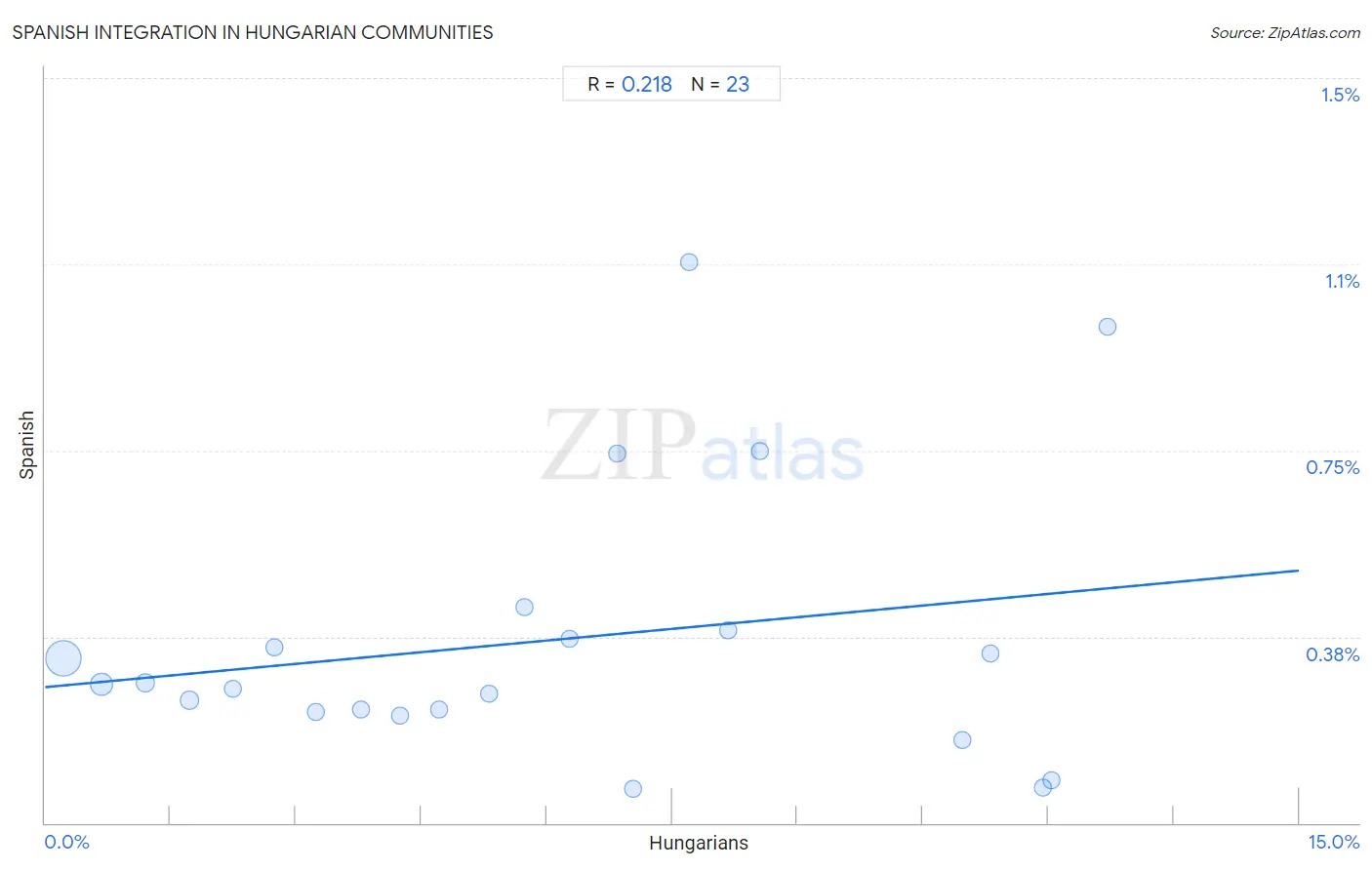
Hungarian vs Spanish Income
When considering income, the most significant differences between Hungarian and Spanish communities in the United States are seen in per capita income ($45,426 compared to $42,249, a difference of 7.5%), median male earnings ($57,309 compared to $53,576, a difference of 7.0%), and wage/income gap (29.0% compared to 27.1%, a difference of 6.9%). Conversely, both communities are more comparable in terms of householder income under 25 years ($50,247 compared to $50,813, a difference of 1.1%), householder income over 65 years ($61,673 compared to $60,795, a difference of 1.4%), and median female earnings ($39,510 compared to $38,098, a difference of 3.7%).

| Income Metric | Hungarian | Spanish |
| Per Capita Income | Excellent $45,426 | Poor $42,249 |
| Median Family Income | Excellent $105,609 | Fair $99,977 |
| Median Household Income | Good $86,920 | Fair $83,343 |
| Median Earnings | Excellent $47,795 | Poor $45,432 |
| Median Male Earnings | Exceptional $57,309 | Fair $53,576 |
| Median Female Earnings | Average $39,510 | Tragic $38,098 |
| Householder Age | Under 25 years | Tragic $50,247 | Tragic $50,813 |
| Householder Age | 25 - 44 years | Excellent $97,544 | Fair $92,200 |
| Householder Age | 45 - 64 years | Excellent $103,913 | Fair $98,554 |
| Householder Age | Over 65 years | Good $61,673 | Average $60,795 |
| Wage/Income Gap | Tragic 29.0% | Tragic 27.1% |
Hungarian vs Spanish Poverty
When considering poverty, the most significant differences between Hungarian and Spanish communities in the United States are seen in single father poverty (18.5% compared to 16.7%, a difference of 10.7%), seniors poverty over the age of 65 (9.7% compared to 10.6%, a difference of 9.8%), and receiving food stamps (11.0% compared to 12.0%, a difference of 8.5%). Conversely, both communities are more comparable in terms of single mother poverty (29.9% compared to 30.1%, a difference of 0.62%), married-couple family poverty (5.3% compared to 5.3%, a difference of 0.81%), and single male poverty (13.8% compared to 13.6%, a difference of 1.5%).
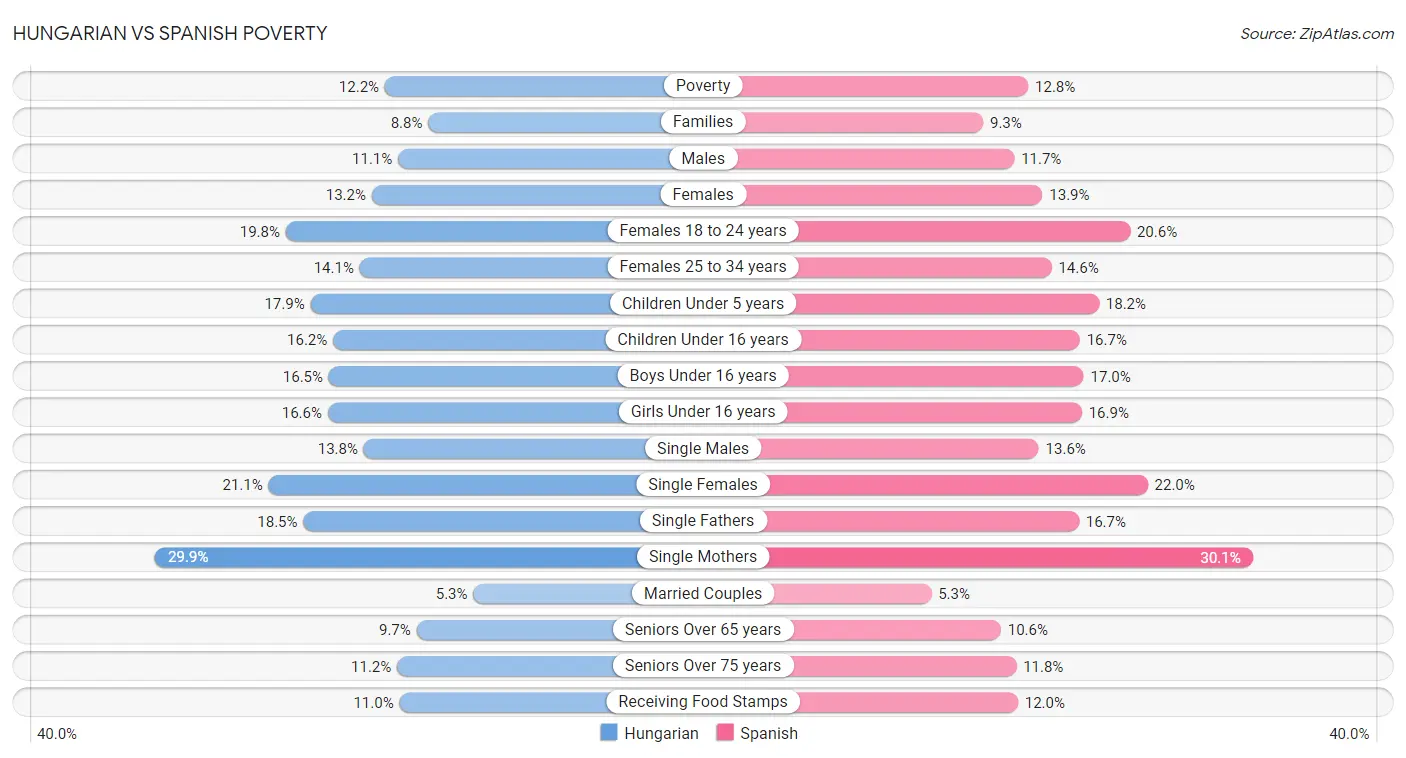
| Poverty Metric | Hungarian | Spanish |
| Poverty | Good 12.2% | Poor 12.8% |
| Families | Good 8.8% | Fair 9.3% |
| Males | Average 11.1% | Poor 11.7% |
| Females | Good 13.2% | Fair 13.9% |
| Females 18 to 24 years | Good 19.8% | Poor 20.6% |
| Females 25 to 34 years | Poor 14.1% | Tragic 14.6% |
| Children Under 5 years | Poor 17.9% | Tragic 18.2% |
| Children Under 16 years | Average 16.2% | Fair 16.7% |
| Boys Under 16 years | Average 16.5% | Fair 17.0% |
| Girls Under 16 years | Average 16.6% | Fair 16.9% |
| Single Males | Tragic 13.8% | Tragic 13.6% |
| Single Females | Fair 21.1% | Tragic 22.0% |
| Single Fathers | Tragic 18.5% | Poor 16.7% |
| Single Mothers | Poor 29.9% | Tragic 30.1% |
| Married Couples | Fair 5.3% | Average 5.3% |
| Seniors Over 65 years | Exceptional 9.7% | Good 10.6% |
| Seniors Over 75 years | Exceptional 11.2% | Excellent 11.8% |
| Receiving Food Stamps | Excellent 11.0% | Fair 12.0% |
Hungarian vs Spanish Unemployment
When considering unemployment, the most significant differences between Hungarian and Spanish communities in the United States are seen in unemployment among seniors over 75 years (10.1% compared to 9.1%, a difference of 10.4%), unemployment among ages 30 to 34 years (5.5% compared to 5.8%, a difference of 6.4%), and female unemployment (4.9% compared to 5.2%, a difference of 6.1%). Conversely, both communities are more comparable in terms of unemployment among ages 20 to 24 years (10.2% compared to 10.1%, a difference of 0.71%), unemployment among ages 60 to 64 years (4.9% compared to 4.8%, a difference of 0.91%), and unemployment among ages 25 to 29 years (6.8% compared to 6.8%, a difference of 1.2%).
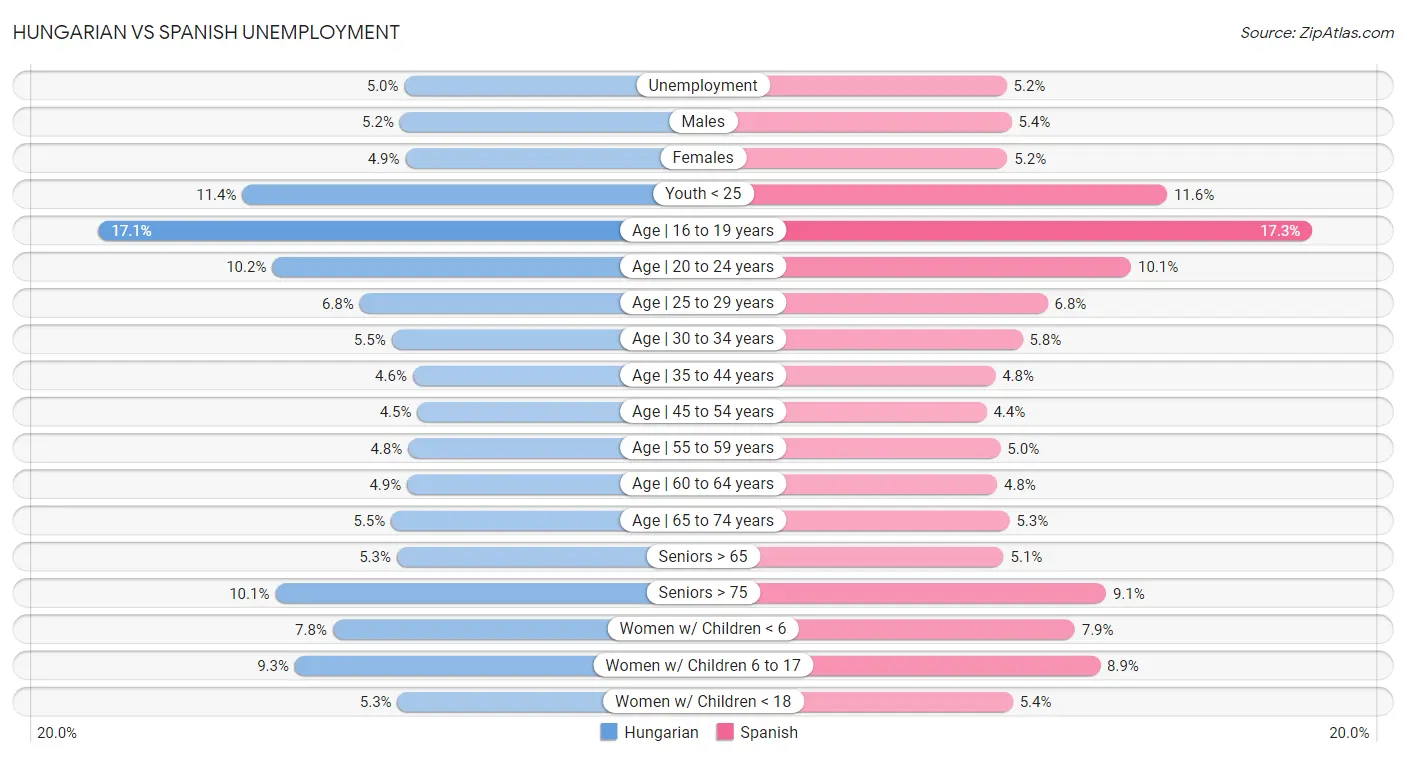
| Unemployment Metric | Hungarian | Spanish |
| Unemployment | Exceptional 5.0% | Good 5.2% |
| Males | Excellent 5.2% | Poor 5.4% |
| Females | Exceptional 4.9% | Average 5.2% |
| Youth < 25 | Excellent 11.4% | Good 11.6% |
| Age | 16 to 19 years | Exceptional 17.1% | Good 17.3% |
| Age | 20 to 24 years | Good 10.2% | Excellent 10.1% |
| Age | 25 to 29 years | Fair 6.8% | Poor 6.8% |
| Age | 30 to 34 years | Average 5.5% | Tragic 5.8% |
| Age | 35 to 44 years | Good 4.6% | Fair 4.8% |
| Age | 45 to 54 years | Good 4.5% | Excellent 4.4% |
| Age | 55 to 59 years | Average 4.8% | Tragic 5.0% |
| Age | 60 to 64 years | Average 4.9% | Good 4.8% |
| Age | 65 to 74 years | Tragic 5.5% | Good 5.3% |
| Seniors > 65 | Tragic 5.3% | Good 5.1% |
| Seniors > 75 | Tragic 10.1% | Tragic 9.1% |
| Women w/ Children < 6 | Fair 7.8% | Poor 7.9% |
| Women w/ Children 6 to 17 | Tragic 9.3% | Good 8.9% |
| Women w/ Children < 18 | Excellent 5.3% | Average 5.4% |
Hungarian vs Spanish Labor Participation
When considering labor participation, the most significant differences between Hungarian and Spanish communities in the United States are seen in in labor force | age 45-54 (82.7% compared to 81.3%, a difference of 1.7%), in labor force | age 16-19 (39.8% compared to 39.3%, a difference of 1.5%), and in labor force | age 25-29 (84.6% compared to 83.6%, a difference of 1.2%). Conversely, both communities are more comparable in terms of in labor force | age > 16 (63.8% compared to 63.9%, a difference of 0.060%), in labor force | age 20-24 (76.3% compared to 76.4%, a difference of 0.12%), and in labor force | age 30-34 (84.5% compared to 83.5%, a difference of 1.2%).

| Labor Participation Metric | Hungarian | Spanish |
| In Labor Force | Age > 16 | Tragic 63.8% | Tragic 63.9% |
| In Labor Force | Age 20-64 | Tragic 79.2% | Tragic 78.2% |
| In Labor Force | Age 16-19 | Exceptional 39.8% | Exceptional 39.3% |
| In Labor Force | Age 20-24 | Exceptional 76.3% | Exceptional 76.4% |
| In Labor Force | Age 25-29 | Average 84.6% | Tragic 83.6% |
| In Labor Force | Age 30-34 | Fair 84.5% | Tragic 83.5% |
| In Labor Force | Age 35-44 | Fair 84.2% | Tragic 83.2% |
| In Labor Force | Age 45-54 | Fair 82.7% | Tragic 81.3% |
Hungarian vs Spanish Family Structure
When considering family structure, the most significant differences between Hungarian and Spanish communities in the United States are seen in single father households (2.2% compared to 2.5%, a difference of 16.5%), single mother households (5.7% compared to 6.4%, a difference of 13.4%), and births to unmarried women (31.2% compared to 34.1%, a difference of 9.0%). Conversely, both communities are more comparable in terms of family households (64.9% compared to 65.0%, a difference of 0.16%), family households with children (27.6% compared to 27.7%, a difference of 0.23%), and average family size (3.18 compared to 3.23, a difference of 1.5%).

| Family Structure Metric | Hungarian | Spanish |
| Family Households | Exceptional 64.9% | Exceptional 65.0% |
| Family Households with Children | Good 27.6% | Excellent 27.7% |
| Married-couple Households | Exceptional 49.1% | Excellent 47.2% |
| Average Family Size | Tragic 3.18 | Average 3.23 |
| Single Father Households | Exceptional 2.2% | Tragic 2.5% |
| Single Mother Households | Exceptional 5.7% | Fair 6.4% |
| Currently Married | Exceptional 48.8% | Good 47.0% |
| Divorced or Separated | Good 12.0% | Tragic 12.8% |
| Births to Unmarried Women | Good 31.2% | Tragic 34.1% |
Hungarian vs Spanish Vehicle Availability
When considering vehicle availability, the most significant differences between Hungarian and Spanish communities in the United States are seen in no vehicles in household (9.9% compared to 7.9%, a difference of 25.2%), 4 or more vehicles in household (6.4% compared to 7.9%, a difference of 23.7%), and 3 or more vehicles in household (19.8% compared to 23.1%, a difference of 16.7%). Conversely, both communities are more comparable in terms of 1 or more vehicles in household (90.3% compared to 92.3%, a difference of 2.1%), 2 or more vehicles in household (56.5% compared to 60.2%, a difference of 6.5%), and 3 or more vehicles in household (19.8% compared to 23.1%, a difference of 16.7%).

| Vehicle Availability Metric | Hungarian | Spanish |
| No Vehicles Available | Excellent 9.9% | Exceptional 7.9% |
| 1+ Vehicles Available | Excellent 90.3% | Exceptional 92.3% |
| 2+ Vehicles Available | Excellent 56.5% | Exceptional 60.2% |
| 3+ Vehicles Available | Good 19.8% | Exceptional 23.1% |
| 4+ Vehicles Available | Good 6.4% | Exceptional 7.9% |
Hungarian vs Spanish Education Level
When considering education level, the most significant differences between Hungarian and Spanish communities in the United States are seen in no schooling completed (1.6% compared to 1.9%, a difference of 17.8%), professional degree (4.6% compared to 4.2%, a difference of 10.0%), and master's degree (15.6% compared to 14.2%, a difference of 9.6%). Conversely, both communities are more comparable in terms of nursery school (98.5% compared to 98.2%, a difference of 0.27%), kindergarten (98.5% compared to 98.2%, a difference of 0.27%), and 1st grade (98.4% compared to 98.2%, a difference of 0.27%).
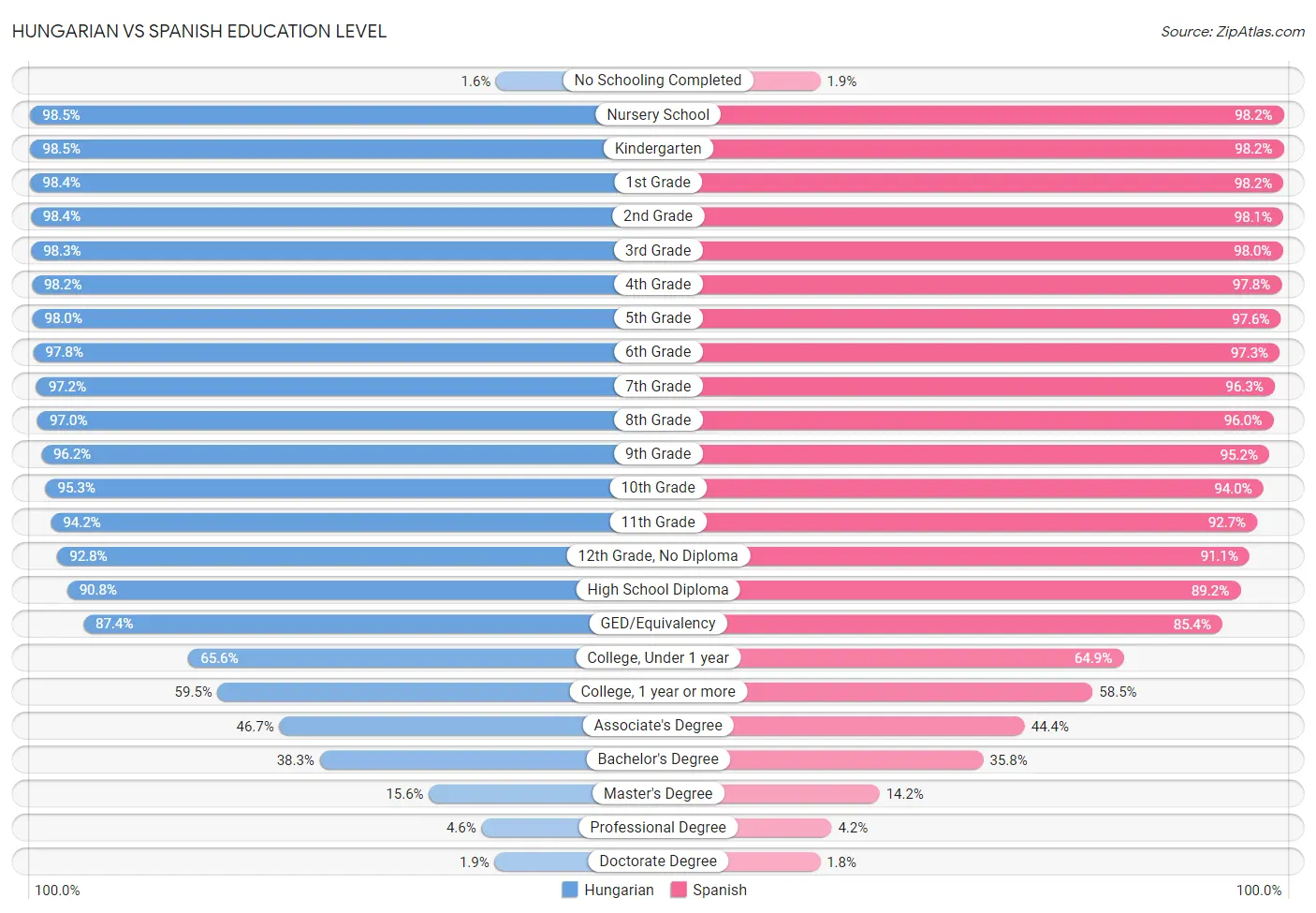
| Education Level Metric | Hungarian | Spanish |
| No Schooling Completed | Exceptional 1.6% | Exceptional 1.9% |
| Nursery School | Exceptional 98.5% | Exceptional 98.2% |
| Kindergarten | Exceptional 98.5% | Exceptional 98.2% |
| 1st Grade | Exceptional 98.4% | Exceptional 98.2% |
| 2nd Grade | Exceptional 98.4% | Exceptional 98.1% |
| 3rd Grade | Exceptional 98.3% | Exceptional 98.0% |
| 4th Grade | Exceptional 98.2% | Exceptional 97.8% |
| 5th Grade | Exceptional 98.0% | Exceptional 97.6% |
| 6th Grade | Exceptional 97.8% | Exceptional 97.3% |
| 7th Grade | Exceptional 97.2% | Excellent 96.3% |
| 8th Grade | Exceptional 97.0% | Excellent 96.0% |
| 9th Grade | Exceptional 96.2% | Excellent 95.2% |
| 10th Grade | Exceptional 95.3% | Good 94.0% |
| 11th Grade | Exceptional 94.2% | Good 92.7% |
| 12th Grade, No Diploma | Exceptional 92.8% | Average 91.1% |
| High School Diploma | Exceptional 90.8% | Average 89.2% |
| GED/Equivalency | Exceptional 87.4% | Fair 85.4% |
| College, Under 1 year | Average 65.6% | Fair 64.9% |
| College, 1 year or more | Average 59.5% | Fair 58.5% |
| Associate's Degree | Average 46.7% | Tragic 44.4% |
| Bachelor's Degree | Good 38.3% | Tragic 35.8% |
| Master's Degree | Good 15.6% | Poor 14.2% |
| Professional Degree | Excellent 4.6% | Fair 4.2% |
| Doctorate Degree | Good 1.9% | Average 1.8% |
Hungarian vs Spanish Disability
When considering disability, the most significant differences between Hungarian and Spanish communities in the United States are seen in vision disability (2.1% compared to 2.4%, a difference of 14.2%), disability age 35 to 64 (11.4% compared to 12.7%, a difference of 11.1%), and disability age 65 to 74 (22.4% compared to 24.6%, a difference of 9.8%). Conversely, both communities are more comparable in terms of disability age 5 to 17 (5.8% compared to 6.0%, a difference of 2.0%), disability age over 75 (46.5% compared to 48.0%, a difference of 3.2%), and female disability (12.5% compared to 13.0%, a difference of 4.1%).
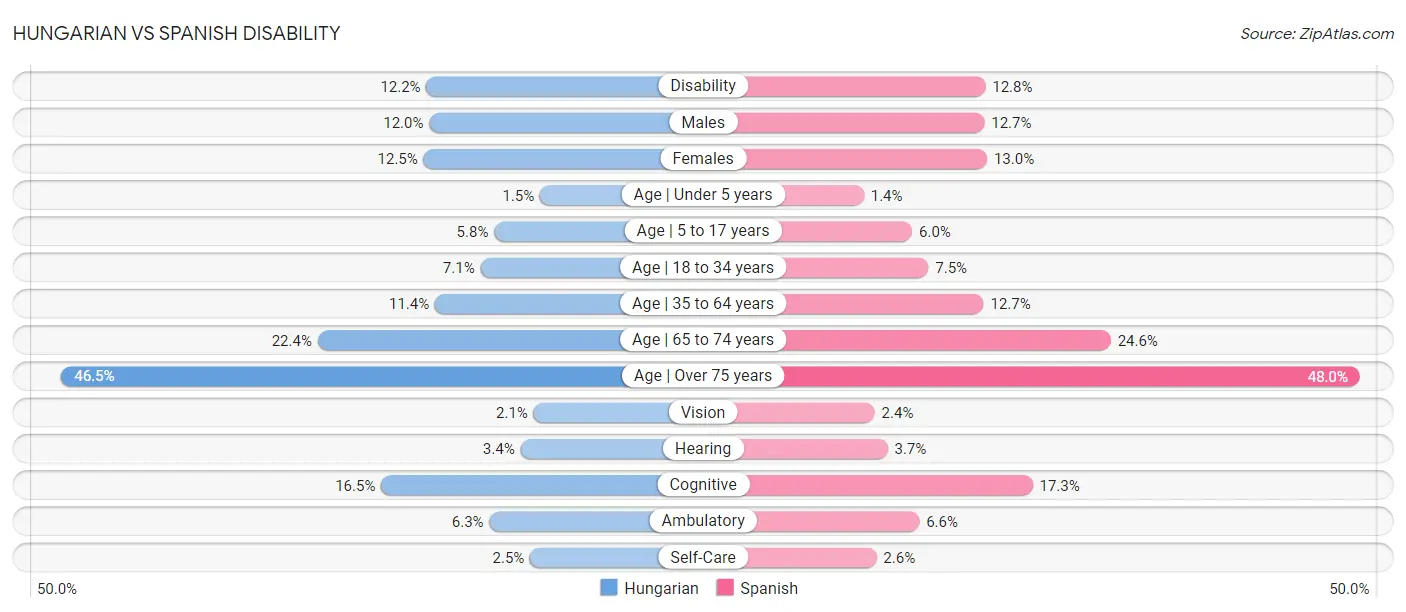
| Disability Metric | Hungarian | Spanish |
| Disability | Tragic 12.2% | Tragic 12.8% |
| Males | Tragic 12.0% | Tragic 12.7% |
| Females | Tragic 12.5% | Tragic 13.0% |
| Age | Under 5 years | Tragic 1.5% | Tragic 1.4% |
| Age | 5 to 17 years | Tragic 5.8% | Tragic 6.0% |
| Age | 18 to 34 years | Tragic 7.1% | Tragic 7.5% |
| Age | 35 to 64 years | Fair 11.4% | Tragic 12.7% |
| Age | 65 to 74 years | Exceptional 22.4% | Tragic 24.6% |
| Age | Over 75 years | Exceptional 46.5% | Tragic 48.0% |
| Vision | Good 2.1% | Tragic 2.4% |
| Hearing | Tragic 3.4% | Tragic 3.7% |
| Cognitive | Exceptional 16.5% | Average 17.3% |
| Ambulatory | Tragic 6.3% | Tragic 6.6% |
| Self-Care | Average 2.5% | Tragic 2.6% |